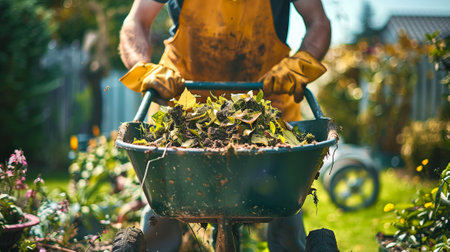Understanding Composting and Its Benefits
Composting is a natural process that transforms kitchen scraps and garden waste into nutrient-rich material, known as compost, which can be used to enhance soil health on your allotment. In the UK, where sustainability and responsible resource management are becoming increasingly important, composting plays a crucial role in reducing landfill waste while providing an environmentally friendly way to recycle organic matter. By actively composting on your allotment, you not only minimise the amount of biodegradable waste sent to landfill but also contribute to the creation of a closed-loop system that enriches your soil without relying on synthetic fertilisers. This sustainable practice helps maintain soil structure, supports beneficial microorganisms, and reduces the carbon footprint associated with waste disposal. Understanding the fundamental principles of composting is essential for every UK allotment holder who wishes to manage their plot responsibly and promote long-term environmental stewardship.
2. Choosing the Right Composting System for Your Allotment
Selecting an appropriate composting system is fundamental for successful and responsible organic waste management on your allotment. The British climate—with its cool, wet winters and often unpredictable summers—alongside the typically compact size of UK allotment plots, shapes the best options for composting kitchen scraps and garden waste effectively.
Composting Options: Bins, Heaps, and More
There are several popular composting methods suited to British allotments. Each comes with its own set of advantages and limitations, particularly when considering local weather conditions and space constraints. The table below offers a comparison:
| System Type | Key Features | Suitability for British Allotments | Considerations |
|---|---|---|---|
| Compost Bins | Enclosed units (plastic or wooden); retains heat and moisture; reduces pests. | Ideal for small plots; efficient decomposition even in cooler temperatures. | Requires regular turning; may need more than one bin for continuous use. |
| Compost Heaps | Open piles; easy to set up; accommodates large volumes quickly. | Best for larger plots or communal spaces; less effective in very wet weather without covering. | Prone to rodents and slow breakdown if not maintained; can become waterlogged. |
| Tumbling Composters | Rotating drum design; speeds up composting process; minimal effort to turn. | Good for those with limited mobility or time; compact size suits smaller plots. | Limited capacity; initial cost higher than simple bins or heaps. |
| Bokashi Bins | Anaerobic fermentation system suitable for kitchen waste, including cooked food. | Perfect as an indoor pre-compost option during colder months. | Bokashi material needs to be finished off in a traditional heap or bin outdoors. |
Factors to Consider in the British Context
Space: Allotments in the UK are often modest in size, so compact solutions like stackable bins or tumblers are frequently preferred.
Weather: Persistent rain can saturate open heaps, leading to soggy compost. Enclosed bins or covered heaps help regulate moisture levels.
Pest Control: Urban and suburban sites may face issues with rats or foxes. Closed systems significantly reduce this risk.
Aesthetics and Regulations: Many allotment associations have guidelines regarding the appearance and placement of composters. Discreet bins are usually favoured over untidy heaps.
Sustainable Practice Tip
If space allows, consider using a two-bin system: one active bin for current additions and another for maturing compost. This rotation keeps the process efficient and manageable throughout Britain’s changing seasons.
![]()
3. What to Compost: Kitchen Scraps and Garden Waste
Understanding what materials are suitable for composting is essential for maintaining a healthy and efficient compost heap on your allotment. By selecting the right ingredients, you will not only reduce waste but also produce nutrient-rich compost to benefit your soil and crops. In the UK, typical kitchen scraps and garden waste generated from allotments provide an ideal mix for successful composting.
Kitchen Scraps Suitable for Composting
Common kitchen scraps that can be safely added to your compost heap include fruit and vegetable peelings, coffee grounds, tea bags (ensure they are plastic-free), crushed eggshells, stale bread, and small amounts of paper towels or napkins. These materials are high in nitrogen and help to accelerate the decomposition process. It is important to avoid adding cooked food, meat, dairy products, or oily substances as these can attract pests and cause unpleasant odours.
Garden Waste Ideal for Composting
Your allotment will generate a variety of green and brown garden waste suitable for composting. Green materials, such as grass clippings, soft prunings, annual weeds (before they set seed), and spent bedding plants provide moisture and nitrogen. Brown materials, including dried leaves, straw, woody prunings (chopped into small pieces), cardboard, and shredded newspaper add carbon and improve aeration within the heap. Balancing these elements is crucial; aim for an even mix of greens and browns to achieve optimum decomposition.
Items to Avoid
For responsible composting on your allotment, avoid adding perennial weeds like bindweed or couch grass roots, invasive plant material, diseased plants, or large branches which decompose slowly. Likewise, pet waste should never be included due to potential pathogens. Sticking to recommended materials ensures your compost remains safe and effective for use throughout the growing season.
4. Best Practices for Responsible Composting
To ensure that your composting efforts on the allotment are both effective and environmentally responsible, it is essential to adopt a series of best practices. The following strategies are tailored to UK conditions and focus on maintaining a productive compost heap while managing common challenges such as pests, odours, aeration, and moisture levels.
Compost Heap Management Strategies
| Aspect | Best Practice | Benefits |
|---|---|---|
| Pest Control | Cover food scraps with brown materials (e.g., leaves, cardboard); use secure bins; avoid adding meat or dairy; turn regularly to disturb pests. | Reduces attraction of rodents and flies; maintains hygiene. |
| Odour Prevention | Balance greens (kitchen scraps) and browns (garden waste); avoid overloading with wet materials; cover smelly items immediately. | Keeps compost smelling earthy rather than sour or rotten. |
| Aeration | Turn the heap every 1-2 weeks using a garden fork; create air pockets by adding coarse materials like twigs. | Promotes decomposition; prevents anaerobic conditions and unpleasant smells. |
| Moisture Management | Keep heap as moist as a wrung-out sponge; cover during heavy rain to prevent waterlogging; add water during dry spells. | Encourages microbial activity; prevents the pile from becoming too dry or soggy. |
Pest Control Specifics for UK Allotments
Foxes and rats can be persistent visitors to UK allotments. To deter them, always use a lidded compost bin or make sure your open heap is well-covered with a tarpaulin or carpet off-cut. Avoid adding cooked foods, oils, or animal products, as these are particularly attractive to pests. Regular turning and keeping the area around the heap tidy will also discourage nesting.
Odour Prevention Tips for British Weather
The UKs damp climate can sometimes lead to overly wet heaps, which may start to smell. To counter this, incorporate plenty of dry brown material such as shredded newspaper or straw, especially after periods of rainfall. If your compost starts to smell sour, its likely too wet—turn it more frequently and add extra carbon-rich material.
Aeration Techniques Suited to Local Materials
Aeration is crucial in preventing your compost from becoming compacted and anaerobic. Using locally available woody prunings or hedge trimmings at the base of your heap helps improve airflow. For larger heaps, inserting perforated pipes vertically into the pile can further enhance oxygen distribution without frequent turning.
Moisture Management Throughout the Seasons
UK weather can be unpredictable, so adjust your approach seasonally. In wet months, cover your heap and elevate it if possible to prevent waterlogging. During drier spells, collect rainwater in a butt and sprinkle it onto the heap if it dries out. Monitoring moisture by squeezing a handful—aim for damp but not dripping—ensures optimal conditions year-round.
5. Composting Do’s and Don’ts on an Allotment
Composting Do’s: Best Practices for UK Allotments
What to Compost
On a British allotment, it is essential to compost responsibly by including only suitable materials. You can add most kitchen vegetable peelings, fruit scraps (excluding citrus in excess), tea bags (preferably plastic-free), coffee grounds, crushed eggshells, grass clippings, garden prunings, annual weeds (before they set seed), and cardboard or paper in moderation. These materials break down well and enrich your compost with nutrients suited for the local soil types.
Respecting Local Regulations
Many allotment sites across the UK have specific guidelines about what can be composted to avoid attracting pests and causing odours. Always check your site’s regulations—some councils prohibit cooked food, meat, fish, dairy products, or bread in compost bins due to the risk of rats and foxes. Using a closed compost bin rather than an open heap is often encouraged to keep wildlife at bay and maintain good neighbourly relations.
Composting Don’ts: What to Avoid
Unacceptable Materials
Do not add meat, bones, fish, dairy, oils, or cooked foods to your allotment compost as these attract vermin and create unpleasant smells. Avoid composting perennial weeds like bindweed or couch grass roots, diseased plant material, glossy magazines, large quantities of citrus peel, or pet waste. These items either fail to decompose properly or pose risks to soil health and site hygiene.
Culturally Informed Etiquette
Beyond written rules, unwritten allotment etiquette plays a big part in communal harmony. Avoid placing invasive plant roots or weed seeds in shared compost heaps; this prevents spread across plots. Always keep your compost area tidy—overflowing heaps are frowned upon and may breach site standards. If sharing facilities, leave space for others and refrain from using strong-smelling ingredients that might offend neighbouring plot holders.
Summary
By following both official regulations and local customs regarding composting on your allotment, you will help sustain healthy soil, maintain good relationships with fellow gardeners, and contribute positively to your community’s green spaces.
6. Using Finished Compost on Your Allotment
Once your compost has broken down into a dark, crumbly, and earthy-smelling material, it’s ready to be used across your allotment. Applying finished compost at the right time and in the correct manner is key to maximising its benefits for soil health and crop yields.
When to Apply Finished Compost
The optimal periods for spreading compost on UK allotments are late autumn or early spring. In autumn, applying compost allows nutrients to integrate with the soil over winter, readying beds for spring planting. In spring, top-dressing beds before sowing or transplanting gives crops an immediate nutrient boost.
How to Use Compost for Different Crops
General Application Methods
Spread a 2-5cm layer of finished compost over your growing beds and gently fork it into the topsoil, taking care not to disturb existing plant roots. For no-dig plots, simply apply as a mulch; earthworms and other soil organisms will work it in naturally.
Specific Crop Tips
Root Vegetables (Carrots, Parsnips, Beetroot)
Use well-matured compost sparingly to avoid overly rich conditions that can lead to forked or misshapen roots. A light mulch or incorporation before sowing is ideal.
Potatoes
Apply a generous layer of compost both at planting time and as a top-up when earthing up. This improves tuber development and reduces scab risk.
Brassicas (Cabbages, Broccoli, Kale)
Brassicas benefit from rich soil; dig in plenty of compost ahead of planting to support their heavy feeding requirements.
Legumes (Peas, Beans)
Add moderate amounts of compost before sowing; excessive richness is unnecessary as legumes fix their own nitrogen but still appreciate improved structure and moisture retention.
Soft Fruits (Strawberries, Raspberries, Currants)
A thick mulch of compost in spring helps retain moisture, suppress weeds, and gradually feeds fruit bushes throughout the growing season.
Sustainable Compost Use Practices
Always reserve some finished compost for mid-season top-dressing or for creating potting mixes. Avoid using unfinished compost directly around plants as it may rob nitrogen from the soil during further decomposition. By integrating these techniques into your annual rotation, you support healthy soil structure and thriving crops while maintaining responsible waste management practices on your UK allotment.


